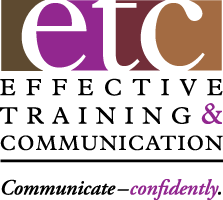Another step in enhancing your Workplace Presenter’s Tool Kit is to polish your facial expression. Remember that your audience only knows what it hears and sees. Not only is your face a great natural visual aid, it can also show nervousness or lack of confidence very quickly and clearly. So … look the part you’re playing – that of a confident and credible presenter.
Smile More
In our culture, we equate a relaxed or smiling facial expression with confidence, credibility and enthusiasm. Once again, the audience’s perception is your reality. A smiling presenter looks like he or she is comfortable on the platform, belongs up there and is passionate, or at least enthusiastic, about the message and its value for the audience. Even when delivering a highly technical topic, the presenter better not look bored or in pain. If so, why should the audience be interested in the message or care about it?
We have three basic types of facial expressions to choose from: the smiling, enthusiastic look, the neutral look and the sad, uncomfortable look. You shouldn’t smile all the time. That would look contrived and distracting. And, of course, it would be inappropriate to smile while delivering a sad or bad news message. So, wear your neutral expression on your face most of the time. Smile whenever you’re enthusiastic or proud about the content to reflect that confidence or passion. Also smile if you say or respond to something amusing.
But, your expression must be authentic for you. If the workplace audience knows you well as a person who doesn’t smile much, smiling on the platform can look fake and be counter-productive. But, there’s a difference between a neutral expression and one that looks like stress, pain or a ‘deer in the headlights’.
Practice Smiling … Really
Most presenters are unaware of how they look on the platform. They’re pre-occupied with the content and dealing with various amounts of Presentation Anxiety. While they may consciously feel their cheeks moving up and mouth opening when they smile, it’s hard to feel the difference between a neutral expression and the painful-looking frown. Add to this dilemma the fact that most people have low physical self-esteem and hate how they look. Remember the hassles involved with taking family photos?
So, learn what that neutral expression feels like. Look in the mirror and find an expression that you can live with and ‘remember’ how that feels. Try to recreate that physical sensation most of the time when you’re speaking.
Right before you begin, subtly relax your facial muscles in private to counteract the tension caused by Presentation Anxiety. Laugh or yawn to loosen them up. While you can practice presenting in front of a mirror, that is really distracting. If you videotape your practice, you’ll see how you look to your audience. You can even have a ‘plant’ in the audience who can give you visual cues to smile more. That same person can also provide time cues if you need them.
While your facial expression is a relatively small tool in your Kit, it can be a powerful one. Increase your awareness your of how you look to the audience, learn how that feels and practice looking the part. If you’re enthusiastic about your content, be sure to tell your face.
